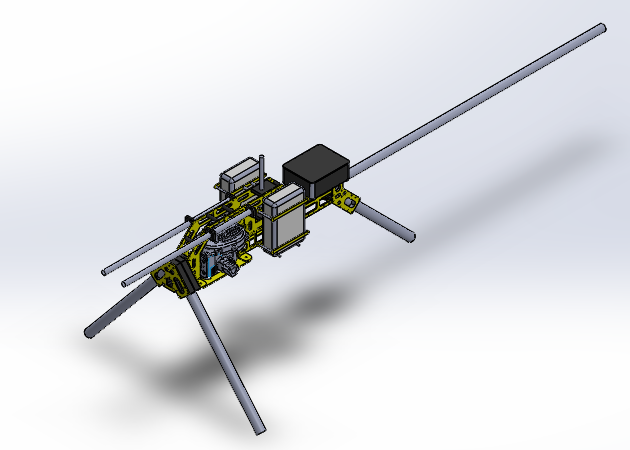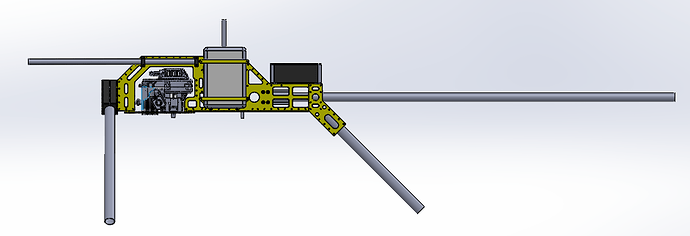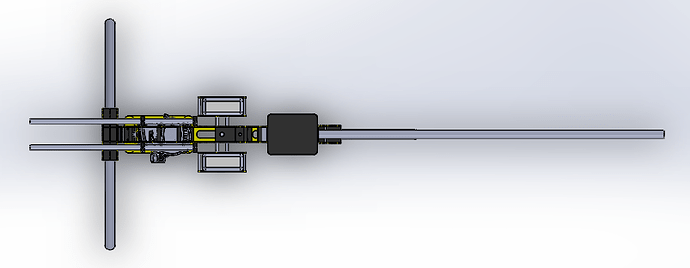I am a 99% user of RTL with 3 aircraft. None of them have tail waging.
Conclusion: They have to come home but don,t like it. Ha, ha.
I have no clue why it does that. The couple of times I’ve used RTL just to test it mine have done it too. Maybe it’s only gassers that does it - it needs to shake its tail like a fish to get going? 
I typically can’t use RTL because when it comes to a stop over the home point it does a hit the brick wall stop thing. Can get by with it with smaller helicopters. But big ones react quite severe to sudden pitch changes like that. And Copter is not exceedingly smooth with a lot of the autonomous stuff for big heli’s.
And Copter is not exceedingly smooth with a lot of the autonomous stuff for big heli’s.
That’s why Bill and you developed the:
L1 navigation for tradheli
I guess.
Well, that is true. We’re trying to improve on the situation for heli. Copter Nav works, but it’s not ideal. Helicopters were kind of forced to adapt to multirotor methods which leaves some things for heli’s being somewhat brutal and inefficient. The L1 Navigation controller is a nice step forward in providing more ideal navigation flight controls for UAV helicopters, and better fits their flight dynamics.
Things like flaring to come to a stop are different between multicopter and helicopter due to the fact that the only basic difference between a helicopter and a fixed-wing in flight is that on the fixed wing the wing doesn’t move - on a helicopter it is rotary. It is impossible for multicopters to have the same flight dynamics as the helicopter because their little tiny rotors don’t have cyclic pitch, they don’t create the lift because they don’t have the blade tip speed of a much larger single rotor (lift is proportional to the square of the speed of the airfoil), so the multicopter does not respond the same to attitude changes. Even very simple things like the ACCEL_Z_P, multirotor requires much higher gain. While using that same gain on a helicopter, with blade tips traveling at 300+ mph and collective pitch varying the lift of the airfoil, will make a helicopter jump and down like a rabbit that has gone nuts. The helicopter has a vastly more powerful and efficient wing for its relative size. And the helicopter is an inherently stable machine - we fly full-size ones every day without any sort of electronic gyro stabilization. It is impossible to fly a multicopter without electronic stabilization.
These differences make helicopter actually easier to fly if you start with a fresh sheet of paper. And understand that in hover, out of translational lift, they are similar to a multicopter. In flight, once it enters translational lift it transitions to being more like a fixed-wing. So things like the L1 Nav are ideally suited to the helicopter. The challenge was getting it to transition back and forth from the hover/slow speed profile to the true flight profile where it’s dynamics as a flying machine take over. So L1 is infinitely smoother than anything we’ve had before for heli’s.
@ChrisOlson,
I have an opportunity to use my heli in a real-world job and would like to pick your brain about sling loading your helis.
The payload I’ll need to carry is around 4-5 pounds. Is there a rule of thumb on how long my line needs to be underneath my heli? Also, I plan to do this flight semi-autonomously (meaning, either in position hold, or loiter). I haven’t had a chance to do auto missions with this yet and don’t want to mess with that right now.
My flight test cards will be dropping the payload from various heights and various speeds. To me, it sounds like the easiest mode would be to do it in loiter mode (with my loiter speed tuned to my desired forward speed - that way I can have my cyclic stick pegged forward during the dropping pass and know that I’m at my target speed and altitude condition.
The particular sling load I plan to carry will be a dropping mechanism at the end of the line, with the drop-able payload firmly attached to it. The dropping mechanism will be no more than a pound. So heaviest I predict is 5 pounds fully loaded, then 1 pound after release.
Things that make me worry is what might happen after the payload is dropped…
My heli is currently tuned well for this aircraft weight (without payload), so I’m hoping it won’t go crazy. If it does, it seems like my best plan of action would be to immediately switch to stabilize mode. I may be pretty high and far from myself to do acro mode.
What are your thoughts?
My heli is quite large spinning 1100mm blades so it seems like 5lbs is just chump change for it.
I do plan to fly an 8lb dumbbell this weekend to practice for this. Is it safe to assume that as long as I’m keeping some forward speed during my flights and passes that the load won’t swing worse and worse?
Thanks for any and all help!
@Chris_Khosravi I know that Chris Olson has busy with a new business venture and I’m not sure whether he will have time to comment. I don’t have experience with what you are asking but I have read some other posts regarding tuning for various payloads for multicopters. Read through this thread https://discuss.ardupilot.org/t/two-crashes-with-an-overpowered-drone/43109/3 . Leonard is the Copter flight controls designer and provides some insight on tuning with payload in the aircraft and not slung below the aircraft. Not sure it helps but thought I would post.
Thank you Bill,
I have read that thread before. Both Leonard and Chris recommend tuning for lightest configuration, then adding payload (which is what I’m doing).
I’ve just never tried slung load flights so I’m trying to imagine all the things that could go wrong 
-Chris Khosravi
Unless it is a spinner or spraying dropping the load gradually, a sling load should only be dropped from a hover, or by setting the load down then dropping the tow line.
It is important to have the cargo hook at the CG of the helicopter so it is free to maneuver in both axes at all times. Set your maximum bank angle to 20 degrees so you don’t overload the helicopter in turns.
Loiter is ok for slow speed and hovering. In translational lift it is best to use the autopilot in auto mode with a carefully designed flight plan when the helicopter is well out of visual reference. The autopilot will do a better job of keeping the load perpendicular under the helicopter than you can.
Your load will trail the helicopter due to aerodynamic load on it. All speed changing has to be done smoothly. Turns have to be constant rate. Your flight plan and nav controller have to be tuned to achieve this. Your cargo hook should be designed to drop the load in an emergency if it gets out of shape.
Long line loads with 20 to 25 foot tow line work the best at cruise speed of 20 to 30kts. The slower you go, the more unstable it will be. The faster you go, the more power it takes. If you are flying a piston or turbine engine be sure to keep tab on engine temps. If you are flying electric, good idea to put on some sort of sensor to keep track of ESC temp. Long line loads take a lot of power.
Well,
I apologize for being stubborn and going against Chris’ recommendations, but I figured I’d post my results from the test I had to do with my heli so other people can benefit from my experience. It was a success. It certainly helps having such a large piston powered helicopter. I was easily able to hit 20m/s ground speed and shedding about 4 pounds instantaneously during the pass. Arduheli handled it like a champ with no signs of issues (that I can see) after looking at the data logs. We did 4 successful drops. All 20m/s passes were done in loiter mode. My loiter is tuned to come to a pretty gentle stop.
Load was about 5 lbs with about 20 feet of line.
Hovering in the same spot resulted in zero swinging when wind is below 10 mph. However up at altitude it was blowing close to 15 which resulted in some swinging (again, helicopter was not being pulled around much at all because of how well arduheli is).
I’m very happy with the results and would like to thank all the developers and people who have helped me from the beginning of this thread.
Hoping to test similar this weekend. What type of line did you use?
Cool! We just used a cheap 20 foot section of paracord we had laying around.
I’ve dropped the heli’s own weight before. Amazing it rises less than a meter. Heck, you can see the effect any time you take off or land with a long line load, whenever the load leaves the ground.
Some closed source autopilots would need a parameter change to remove payload on the ground!
A look in to what I’ve been up to lately with this project:
I never liked the layout of the Airstar International frames. I’m hoping with my design I’ll have a little more freedom with mounting accessories and payloads while keeping CG balanced. Plan is to cut 1/8" or even 3/16" G-10 material for the frame. I want this to be super tough knowing how big it is.
Hey @ChrisOlson🙋🏼♂️
How about the Pixhawk 4 mini? I’m confused about IMU dampening as I read my pixhawk cube have just one dampened IMU. Pixhack V3 is equipped with 3 dampened IMU. Did you have some information about Pixhawk 4 Mini? I’m looking for an Gasser FC so your Help would be great!
Thank you!
I looked at this one briefly in the past and never read anything about it having internally damped IMUs. Otherwise it looks very similar to the CUAV V3.
After what I’ve been through in this thread, I’m sticking with the CUAV V3 even on future helicopters. Or at least until someone proves there is a better one for me. There is now the V3X which is supposedly better. I think Chris Olson has a couple of these that work very well for him.
Thank you @Chris_Khosravi!
I think I let the Pixhawk Cube rest for other wing or Multicopter Projects.
It make sense to trust other users experience with pixhack v3. I’ve checked some Stores here in EU but seems like only chance is to order one in Chinese Stores:face_with_raised_eyebrow:
Matthias,
I replaced a new Pixhawk cube with a new pixhackv3x.
That pixhack v3 is better suited with Helis than other FC. No problems for me to get that with Aliexpress store.
Look up what others write about their experiencing.
![]()
![]() davidT
davidT
Usually from CUAV’s Aliexpress store.
US $188.0 12% OFF|CUAV HOT FREE SHIPPING Pixhack V3 Autopilot Flight Controller…
Smarter Shopping, Better Living! Aliexpress.com
And yes, my Soxos has no damping mechanism. The V3 is also nice, compact and extremely well made.
I believe Chris swears by it as well.
more here: Flybar 450 Heli in loiter mode
So Guys I have to thank you for your experience 
Pixhack v3 is on it’s way 
Welcome to the club! You will love how well it works for helicopters.
@Chris_Khosravi, did you have some another advices for me in sight of external dampening/ mounting the pixhack unit like moon gel or “milton mod” stuff? I’m familar with vibrations on my zenoah gasser:woozy_face:



